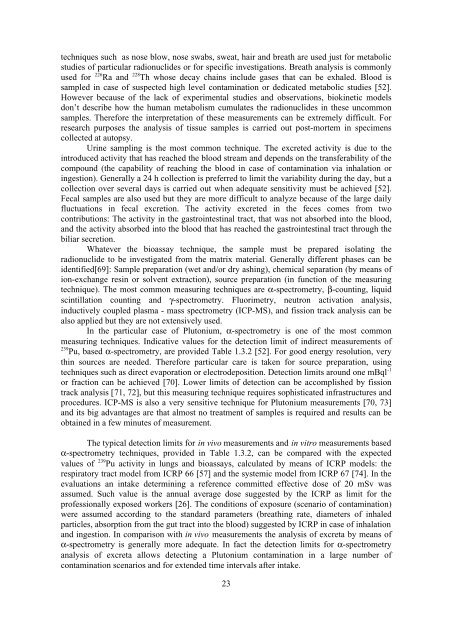Plutonium Biokinetics in Human Body A. Luciani - Kit-Bibliothek - FZK
Plutonium Biokinetics in Human Body A. Luciani - Kit-Bibliothek - FZK
Plutonium Biokinetics in Human Body A. Luciani - Kit-Bibliothek - FZK
You also want an ePaper? Increase the reach of your titles
YUMPU automatically turns print PDFs into web optimized ePapers that Google loves.
techniques such as nose blow, nose swabs, sweat, hair and breath are used just for metabolic<br />
studies of particular radionuclides or for specific <strong>in</strong>vestigations. Breath analysis is commonly<br />
used for 226 Ra and 228 Th whose decay cha<strong>in</strong>s <strong>in</strong>clude gases that can be exhaled. Blood is<br />
sampled <strong>in</strong> case of suspected high level contam<strong>in</strong>ation or dedicated metabolic studies [52].<br />
However because of the lack of experimental studies and observations, biok<strong>in</strong>etic models<br />
don’t describe how the human metabolism cumulates the radionuclides <strong>in</strong> these uncommon<br />
samples. Therefore the <strong>in</strong>terpretation of these measurements can be extremely difficult. For<br />
research purposes the analysis of tissue samples is carried out post-mortem <strong>in</strong> specimens<br />
collected at autopsy.<br />
Ur<strong>in</strong>e sampl<strong>in</strong>g is the most common technique. The excreted activity is due to the<br />
<strong>in</strong>troduced activity that has reached the blood stream and depends on the transferability of the<br />
compound (the capability of reach<strong>in</strong>g the blood <strong>in</strong> case of contam<strong>in</strong>ation via <strong>in</strong>halation or<br />
<strong>in</strong>gestion). Generally a 24 h collection is preferred to limit the variability dur<strong>in</strong>g the day, but a<br />
collection over several days is carried out when adequate sensitivity must be achieved [52].<br />
Fecal samples are also used but they are more difficult to analyze because of the large daily<br />
fluctuations <strong>in</strong> fecal excretion. The activity excreted <strong>in</strong> the feces comes from two<br />
contributions: The activity <strong>in</strong> the gastro<strong>in</strong>test<strong>in</strong>al tract, that was not absorbed <strong>in</strong>to the blood,<br />
and the activity absorbed <strong>in</strong>to the blood that has reached the gastro<strong>in</strong>test<strong>in</strong>al tract through the<br />
biliar secretion.<br />
Whatever the bioassay technique, the sample must be prepared isolat<strong>in</strong>g the<br />
radionuclide to be <strong>in</strong>vestigated from the matrix material. Generally different phases can be<br />
identified[69]: Sample preparation (wet and/or dry ash<strong>in</strong>g), chemical separation (by means of<br />
ion-exchange res<strong>in</strong> or solvent extraction), source preparation (<strong>in</strong> function of the measur<strong>in</strong>g<br />
technique). The most common measur<strong>in</strong>g techniques are α-spectrometry, β-count<strong>in</strong>g, liquid<br />
sc<strong>in</strong>tillation count<strong>in</strong>g and γ-spectrometry. Fluorimetry, neutron activation analysis,<br />
<strong>in</strong>ductively coupled plasma - mass spectrometry (ICP-MS), and fission track analysis can be<br />
also applied but they are not extensively used.<br />
In the particular case of <strong>Plutonium</strong>, α-spectrometry is one of the most common<br />
measur<strong>in</strong>g techniques. Indicative values for the detection limit of <strong>in</strong>direct measurements of<br />
239 Pu, based α-spectrometry, are provided Table 1.3.2 [52]. For good energy resolution, very<br />
th<strong>in</strong> sources are needed. Therefore particular care is taken for source preparation, us<strong>in</strong>g<br />
techniques such as direct evaporation or electrodeposition. Detection limits around one mBql -1<br />
or fraction can be achieved [70]. Lower limits of detection can be accomplished by fission<br />
track analysis [71, 72], but this measur<strong>in</strong>g technique requires sophisticated <strong>in</strong>frastructures and<br />
procedures. ICP-MS is also a very sensitive technique for <strong>Plutonium</strong> measurements [70, 73]<br />
and its big advantages are that almost no treatment of samples is required and results can be<br />
obta<strong>in</strong>ed <strong>in</strong> a few m<strong>in</strong>utes of measurement.<br />
The typical detection limits for <strong>in</strong> vivo measurements and <strong>in</strong> vitro measurements based<br />
α-spectrometry techniques, provided <strong>in</strong> Table 1.3.2, can be compared with the expected<br />
values of 239 Pu activity <strong>in</strong> lungs and bioassays, calculated by means of ICRP models: the<br />
respiratory tract model from ICRP 66 [57] and the systemic model from ICRP 67 [74]. In the<br />
evaluations an <strong>in</strong>take determ<strong>in</strong><strong>in</strong>g a reference committed effective dose of 20 mSv was<br />
assumed. Such value is the annual average dose suggested by the ICRP as limit for the<br />
professionally exposed workers [26]. The conditions of exposure (scenario of contam<strong>in</strong>ation)<br />
were assumed accord<strong>in</strong>g to the standard parameters (breath<strong>in</strong>g rate, diameters of <strong>in</strong>haled<br />
particles, absorption from the gut tract <strong>in</strong>to the blood) suggested by ICRP <strong>in</strong> case of <strong>in</strong>halation<br />
and <strong>in</strong>gestion. In comparison with <strong>in</strong> vivo measurements the analysis of excreta by means of<br />
α-spectrometry is generally more adequate. In fact the detection limits for α-spectrometry<br />
analysis of excreta allows detect<strong>in</strong>g a <strong>Plutonium</strong> contam<strong>in</strong>ation <strong>in</strong> a large number of<br />
contam<strong>in</strong>ation scenarios and for extended time <strong>in</strong>tervals after <strong>in</strong>take.<br />
23












![{A1[]Sp - Bibliothek](https://img.yumpu.com/21908054/1/184x260/a1sp-bibliothek.jpg?quality=85)




